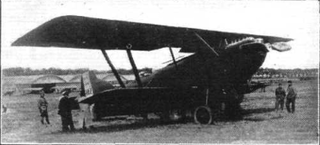
The Bristol M.1 Monoplane Scout was a British monoplane fighter of the First World War. It holds the distinction of being the only British monoplane fighter to reach production during the conflict.

The Avro 534 Baby was a British single-seat light sporting biplane built shortly after the First World War.

The Deperdussin Monocoque was an early racing aircraft built in 1912 by the Aéroplanes Deperdussin, a French aircraft manufacturer started in 1911 and reorganized as the Société Pour L'Aviation et ses Dérivés (SPAD) in 1913. It is so named because of the method of construction of its fuselage. The aircraft is noted for winning the Gordon Bennett Trophy in 1912 and 1913, and for raising the world speed record for aircraft to 130 mph (210 km/h).

The Dayton-Wright RB-1 , also known simply as the Dayton-Wright Racer was a high wing single-engine monoplane racing aircraft developed in the United States to participate in the 1920 Gordon Bennett Cup air race.

The DFW Mars was an early German military utility aircraft built in 1913 and was the first original design manufactured by DFW. The aircraft was produced in both monoplane and biplane versions, which shared a common fuselage and empennage. The monoplane version featured wings that were wire-braced to a kingpost on the forward fuselage, and was powered by a 71 kW (90 hp) NAG engine. Examples of the monoplane built as dedicated trainer aircraft also incorporated a reinforcing truss beneath the wings. The biplane had conventional three-bay wings of unequal span and was powered by a 75 kW (100 hp) Mercedes engine. The wings of both the monoplane and biplane versions featured prominent sweepback.

The Fokker F.II was the first of a long series of commercial aircraft from the Fokker Aircraft Company, flying in 1919. In a biplane age, it presented a distinct clean, high-wing monoplane style that sold successfully across Europe and North America during the development of commercial passenger-carrying aviation.
The Bristol Type 32 Bullet was a British biplane racing aircraft. It was designed in 1919 by Frank Barnwell as a high-speed testbed for the Jupiter engine being developed in Bristol by Roy Fedden for the Cosmos Engineering company, and also to publicise the company's name by participating in air races.

The Loening S-1 Flying Yacht, also called the Loening Model 23, was an early light monoplane flying boat designed in the United States by Grover Loening in the early 1920s. The aircraft won the 1921 Collier Trophy.
The Gnosspelius Gull was a 1920s British experimental ultra-light monoplane designed by Major O.T. Gnosspelius and built by Short Brothers at Rochester for the 1923 Lympne light aircraft trials.

The de Havilland DH.81 Swallow Moth was aimed at the low-cost sporting aircraft market during the Great Depression. It was a single-engined two-seat low-wing monoplane; only one was built.

The Boulton & Paul P.8 Atlantic was Boulton & Paul's attempt to adapt their well-performing Bourges bomber into an airliner. They hoped to gain publicity for it by winning the outstanding prize for the first non-stop Atlantic crossing but a first flight accident made them miss their opportunity. Two were built but none sold as airliners.
The RAE Hurricane was a single-seat, single-engined light monoplane designed and built by the Aero Club of the Royal Aircraft Establishment for the 1923 Lympne Motor Glider Competition. It was underpowered with an unreliable engine. Re-engined, it flew in many races, with first place in the 1926 Grosvenor Challenge Cup its greatest success.

The Handasyde monoplane was a single-seat light aircraft built for the 1923 Lympne motor glider competition. It competed there but won no prizes.

The Bellanca CF is an early enclosed high-wing monoplane designed by Giuseppe Mario Bellanca that led to a successful series of Bellanca aircraft. Bellanca was nominated for the Collier Trophy in 1922 for the CF design.

The Farman FF 65 Sport was a French built light biplane, with a single engine and tandem seats, intended for sport and touring. First flown in 1919, it achieved modest sales at home and abroad in the early 1920s. Two unusual modifications produced a biplane glider and a low aspect ratio parasol wing machine.

Frederick Phillips Raynham (1893–1954) was a British pilot from the early days of aviation, gaining his aviator's certificate in 1911. He test-flew Avro, Martinsyde, Sopwith and Hawker aircraft before and after World War I. He later formed the Aircraft Survey Co. and the Indian Air Survey and Transport Co., flying in India and Burma.

The Curtiss Model 22 Cox Racers were two specialised racing aircraft built by the American Curtiss Aeroplane and Motor Company. The type was flown as a monoplane, biplane and triplane.

The Potez 28 was a French aircraft designed in the 1920s to set distance records, built in both sesquiplane and monoplane versions. Only two were completed but both set several long distance records.
The Yackey Monoplane was an American three seat parasol monoplane flown in the late 1920s. Two prototypes had some success in the 1927 New York - Spokane National Air Derby and orders were placed but a crash killed its designer and ended production.
The sole Kawanishi K-2 was the first specialized Japanese racing aircraft. The advanced, Junkers-influenced, single seat monoplane's first flight was in the late summer of 1921. It had a promisingly high maximum speed but a career limited by numerous minor accidents produced no victories or records.















